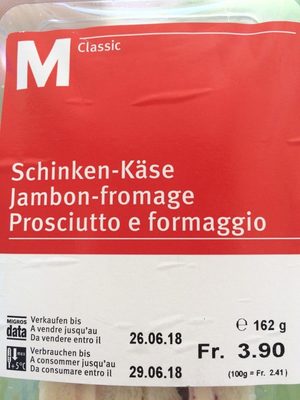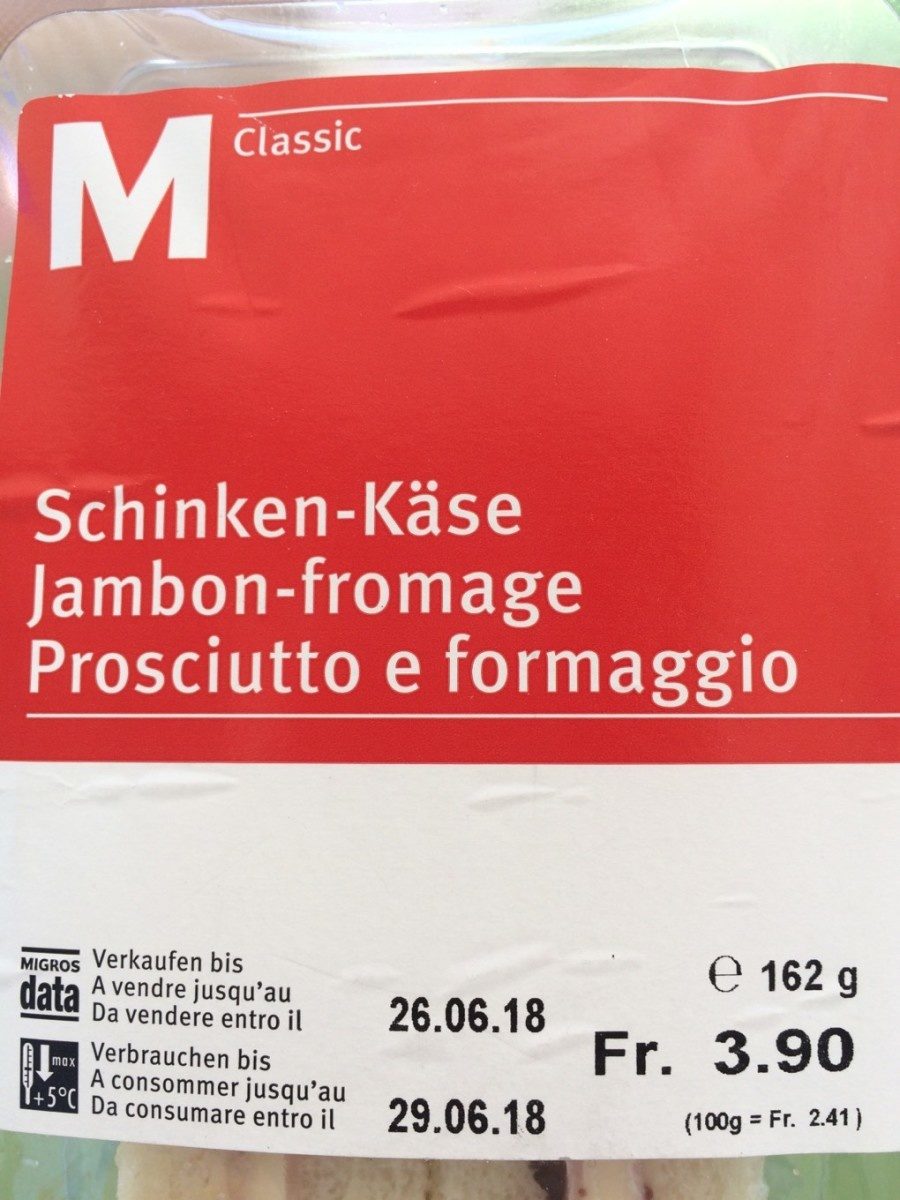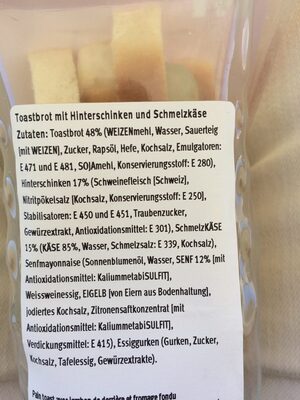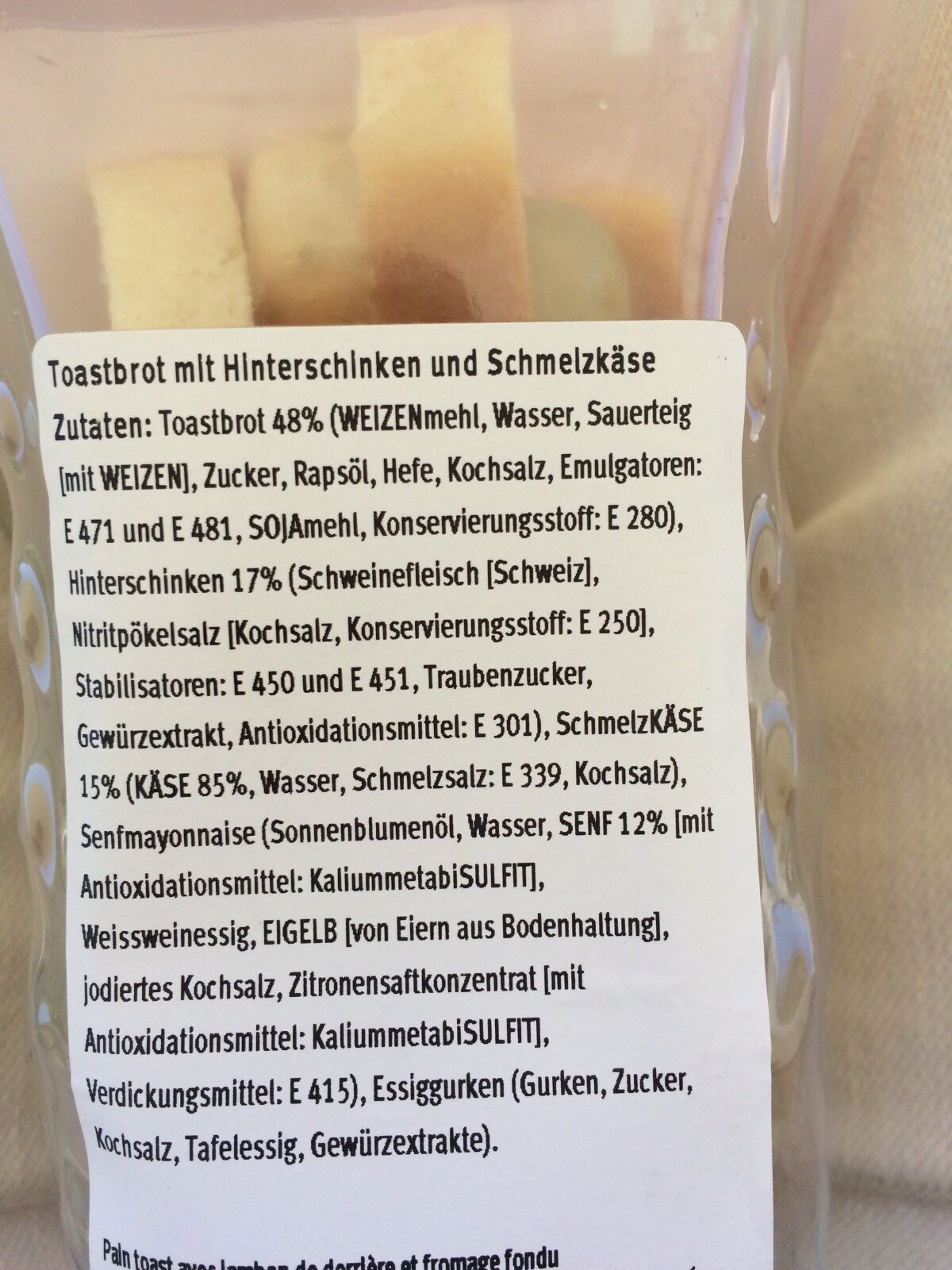Help us make food transparency the norm!
As a non-profit organization, we depend on your donations to continue informing consumers around the world about what they eat.
The food revolution starts with you!
Sandwich Jambon fromage - M Classic - 162 g
Sandwich Jambon fromage - M Classic - 162 g
This product page is not complete. You can help to complete it by editing it and adding more data from the photos we have, or by taking more photos using the app for Android or iPhone/iPad. Thank you!
×
Barcode: 7613269251071 (EAN / EAN-13)
Quantity: 162 g
Brands: M Classic
Categories: Sandwiches, Sandwiches filled with cold cuts, Cheese sandwiches, Ham sandwiches, Ham and cheese sandwiches
Labels, certifications, awards: Pure pork
Manufacturing or processing places: Suisse
Stores: Migros
Countries where sold: Switzerland
Matching with your preferences
Health
Ingredients
-
55 ingredients
: Toastbrot 48% (WEIZENmehl, Wasser, Sauerteig (mit WEIZEN], Zucker, Rapsöl, Hefe, Kochsalz, Emulgatoren: E471 und E 481, SOJAmehl, Konservierungsstoff: E 280), Hinterschinken 17% (Schweinefleisch [Schweiz], Nitritpökelsalz [Kochsalz, Konservierungsstoff: E 250], Stabilisatoren: E 450 und E 451, Traubenzucker, Gewürzextrakt, Antioxidationsmittel: E 301), SchmelzKASE 15% (KÄSE 85%, Wasser, Schmelzsalz: E 339, Kochsalz), Senfmayonnaise (Sonnenblumenöl, Wasser, SENF 12% [mit Antioxidationsmittel: KaliummetabiSULFIT), Weissweinessig, EIGELB [von Eiern aus Boden haltung], jodiertes Kochsalz, Zitronensaftkonzentrat [mit Antioxidationsmittel: KaliummetabiSULFIT), Verdickungsmittel: E 415), Essiggurken (Gurken, Zucker, Kochsalz, Tafelessig, Gewürzextrakte).Allergens: Eggs, Gluten, Milk, Mustard, Soybeans
Food processing
-
Ultra processed foods
Elements that indicate the product is in the 4 - Ultra processed food and drink products group:
- Additive: E415 - Xanthan gum
- Additive: E450 - Diphosphates
- Additive: E451 - Triphosphates
- Additive: E471 - Mono- and diglycerides of fatty acids
- Additive: E481 - Sodium stearoyl-2-lactylate
- Ingredient: Emulsifier
- Ingredient: Thickener
Food products are classified into 4 groups according to their degree of processing:
- Unprocessed or minimally processed foods
- Processed culinary ingredients
- Processed foods
- Ultra processed foods
The determination of the group is based on the category of the product and on the ingredients it contains.
Additives
-
E224 - Potassium metabisulphite
Potassium metabisulfite: Potassium metabisulfite, K2S2O5, also known as potassium pyrosulfite, is a white crystalline powder with a pungent sulfur odour. The main use for the chemical is as an antioxidant or chemical sterilant. It is a disulfite and is chemically very similar to sodium metabisulfite, with which it is sometimes used interchangeably. Potassium metabisulfite is generally preferred out of the two as it does not contribute sodium to the diet. Potassium metabisulfite has a monoclinic crystal structure which decomposes at 190 °C, yielding potassium sulfite and sulfur dioxide: K2S2O5-s- → K2SO3-s- + SO2-g-Source: Wikipedia
-
E250 - Sodium nitrite
Sodium nitrite: Sodium nitrite is the inorganic compound with the chemical formula NaNO2. It is a white to slightly yellowish crystalline powder that is very soluble in water and is hygroscopic. It is a useful precursor to a variety of organic compounds, such as pharmaceuticals, dyes, and pesticides, but it is probably best known as a food additive to prevent botulism. It is on the World Health Organization's List of Essential Medicines, the most important medications needed in a basic health system.Nitrate or nitrite -ingested- under conditions that result in endogenous nitrosation has been classified as "probably carcinogenic to humans" by International Agency for Research on Cancer -IARC-.Source: Wikipedia
-
E280 - Propionic acid
Propionic acid: Propionic acid -from the Greek words protos, meaning "first", and pion, meaning "fat"; also known as propanoic acid- is a naturally occurring carboxylic acid with chemical formula CH3CH2CO2H. It is a liquid with a pungent and unpleasant smell somewhat resembling body odor. The anion CH3CH2CO2− as well as the salts and esters of propionic acid are known as propionates -or propanoates-.Source: Wikipedia
-
E301 - Sodium ascorbate
Sodium ascorbate: Sodium ascorbate is one of a number of mineral salts of ascorbic acid -vitamin C-. The molecular formula of this chemical compound is C6H7NaO6. As the sodium salt of ascorbic acid, it is known as a mineral ascorbate. It has not been demonstrated to be more bioavailable than any other form of vitamin C supplement.Sodium ascorbate normally provides 131 mg of sodium per 1‚000 mg of ascorbic acid -1‚000 mg of sodium ascorbate contains 889 mg of ascorbic acid and 111 mg of sodium-. As a food additive, it has the E number E301 and is used as an antioxidant and an acidity regulator. It is approved for use as a food additive in the EU, USA, and Australia and New Zealand.In in vitro studies, sodium ascorbate has been found to produce cytotoxic effects in various malignant cell lines, which include melanoma cells that are particularly susceptible.Source: Wikipedia
-
E339 - Sodium phosphates
Sodium phosphates: Sodium phosphate is a generic term for a variety of salts of sodium -Na+- and phosphate -PO43−-. Phosphate also forms families or condensed anions including di-, tri-, tetra-, and polyphosphates. Most of these salts are known in both anhydrous -water-free- and hydrated forms. The hydrates are more common than the anhydrous forms.Source: Wikipedia
-
E415 - Xanthan gum
Xanthan gum (E415) is a natural polysaccharide derived from fermented sugars, often used in the food industry as a thickening and stabilizing agent.
This versatile food additive enhances texture and prevents ingredient separation in a wide range of products, including salad dressings, sauces, and gluten-free baked goods.
It is considered safe for consumption even at high intake amounts.
-
E450 - Diphosphates
Diphosphates (E450) are food additives often utilized to modify the texture of products, acting as leavening agents in baking and preventing the coagulation of canned food.
These salts can stabilize whipped cream and are also found in powdered products to maintain their flow properties. They are commonly present in baked goods, processed meats, and soft drinks.
Derived from phosphoric acid, they're part of our daily phosphate intake, which often surpasses recommended levels due to the prevalence of phosphates in processed foods and drinks.
Excessive phosphate consumption is linked to health issues, such as impaired kidney function and weakened bone health. Though diphosphates are generally regarded as safe when consumed within established acceptable daily intakes, it's imperative to monitor overall phosphate consumption to maintain optimal health.
-
E451 - Triphosphates
Sodium triphosphate: Sodium triphosphate -STP-, also sodium tripolyphosphate -STPP-, or tripolyphosphate -TPP-,- is an inorganic compound with formula Na5P3O10. It is the sodium salt of the polyphosphate penta-anion, which is the conjugate base of triphosphoric acid. It is produced on a large scale as a component of many domestic and industrial products, especially detergents. Environmental problems associated with eutrophication are attributed to its widespread use.Source: Wikipedia
-
E471 - Mono- and diglycerides of fatty acids
Mono- and diglycerides of fatty acids (E471), are food additives commonly used as emulsifiers in various processed foods.
These compounds consist of glycerol molecules linked to one or two fatty acid chains, which help stabilize and blend water and oil-based ingredients. E471 enhances the texture and shelf life of products like margarine, baked goods, and ice cream, ensuring a smooth and consistent texture.
It is generally considered safe for consumption within established regulatory limits.
-
E481 - Sodium stearoyl-2-lactylate
Sodium stearoyl lactylate: Sodium stearoyl-2-lactylate -sodium stearoyl lactylate or SSL- is a versatile, FDA approved food additive used to improve the mix tolerance and volume of processed foods. It is one type of a commercially available lactylate. SSL is non-toxic, biodegradable, and typically manufactured using biorenewable feedstocks. Because SSL is a safe and highly effective food additive, it is used in a wide variety of products ranging from baked goods and desserts to pet foods.As described by the Food Chemicals Codex 7th edition, SSL is a cream-colored powder or brittle solid. SSL is currently manufactured by the esterification of stearic acid with lactic acid and partially neutralized with either food-grade soda ash -sodium carbonate- or caustic soda -concentrated sodium hydroxide-. Commercial grade SSL is a mixture of sodium salts of stearoyl lactylic acids and minor proportions of other sodium salts of related acids. The HLB for SSL is 10-12. SSL is slightly hygroscopic, soluble in ethanol and in hot oil or fat, and dispersible in warm water. These properties are the reason that SSL is an excellent emulsifier for fat-in-water emulsions and can also function as a humectant.Source: Wikipedia
Ingredients analysis
-
May contain palm oil
Ingredients that may contain palm oil: E471, E481
-
Non-vegan
Non-vegan ingredients: Pork meat, Cheese, Egg yolkSome ingredients could not be recognized.
We need your help!
You can help us recognize more ingredients and better analyze the list of ingredients for this product and others:
- Edit this product page to correct spelling mistakes in the ingredients list, and/or to remove ingredients in other languages and sentences that are not related to the ingredients.
- Add new entries, synonyms or translations to our multilingual lists of ingredients, ingredient processing methods, and labels.
If you would like to help, join the #ingredients channel on our Slack discussion space and/or learn about ingredients analysis on our wiki. Thank you!
-
Non-vegetarian
Non-vegetarian ingredients: Pork meatSome ingredients could not be recognized.
We need your help!
You can help us recognize more ingredients and better analyze the list of ingredients for this product and others:
- Edit this product page to correct spelling mistakes in the ingredients list, and/or to remove ingredients in other languages and sentences that are not related to the ingredients.
- Add new entries, synonyms or translations to our multilingual lists of ingredients, ingredient processing methods, and labels.
If you would like to help, join the #ingredients channel on our Slack discussion space and/or learn about ingredients analysis on our wiki. Thank you!
-
Details of the analysis of the ingredients
We need your help!
Some ingredients could not be recognized.
We need your help!
You can help us recognize more ingredients and better analyze the list of ingredients for this product and others:
- Edit this product page to correct spelling mistakes in the ingredients list, and/or to remove ingredients in other languages and sentences that are not related to the ingredients.
- Add new entries, synonyms or translations to our multilingual lists of ingredients, ingredient processing methods, and labels.
If you would like to help, join the #ingredients channel on our Slack discussion space and/or learn about ingredients analysis on our wiki. Thank you!
: Toastbrot 48% (WEIZENmehl, Wasser, Sauerteig (mit WEIZEN, Zucker, Rapsöl, Hefe, Kochsalz, Emulgatoren (e471), e481, SOJAmehl, Konservierungsstoff (e280)), Hinterschinken 17% (Schweinefleisch, Nitritpökelsalz (Kochsalz, Konservierungsstoff (e250)), Stabilisatoren (e450), e451, Traubenzucker, Gewürzextrakt, Antioxidationsmittel (e301)), SchmelzKASE 15% (KÄSE 85%, Wasser, Schmelzsalz (e339), Kochsalz), Senfmayonnaise (Sonnenblumenöl, Wasser, SENF 12%, mit Antioxidationsmittel (KaliummetabiSULFIT)), Weissweinessig, EIGELB (von Eiern aus Boden haltung), jodiertes Kochsalz, Zitronensaftkonzentrat, mit Antioxidationsmittel (KaliummetabiSULFIT)), Verdickungsmittel (e415), Essiggurken (Gurken, Zucker, Kochsalz, Tafelessig, Gewürzextrakte)- Toastbrot -> de:toastbrot - percent: 48
- WEIZENmehl -> en:wheat-flour - vegan: yes - vegetarian: yes - ciqual_proxy_food_code: 9410
- Wasser -> en:water - vegan: yes - vegetarian: yes - ciqual_food_code: 18066
- Sauerteig -> en:sourdough
- mit WEIZEN -> en:wheat - vegan: yes - vegetarian: yes - ciqual_proxy_food_code: 9410
- Zucker -> en:sugar - vegan: yes - vegetarian: yes - ciqual_proxy_food_code: 31016
- Rapsöl -> en:rapeseed-oil - vegan: yes - vegetarian: yes - from_palm_oil: no
- Hefe -> en:yeast - vegan: yes - vegetarian: yes
- Kochsalz -> en:salt - vegan: yes - vegetarian: yes - ciqual_food_code: 11058
- Emulgatoren -> en:emulsifier
- e471 -> en:e471 - vegan: maybe - vegetarian: maybe - from_palm_oil: maybe
- e481 -> en:e481 - vegan: maybe - vegetarian: maybe - from_palm_oil: maybe
- SOJAmehl -> en:soya-flour - vegan: yes - vegetarian: yes - ciqual_food_code: 20900
- Konservierungsstoff -> en:preservative
- e280 -> en:e280 - vegan: yes - vegetarian: yes
- Hinterschinken -> de:hinterschinken - percent: 17
- Schweinefleisch -> en:pork-meat - vegan: no - vegetarian: no - ciqual_proxy_food_code: 28205
- Nitritpökelsalz -> en:nitrite-curing-salt
- Kochsalz -> en:salt - vegan: yes - vegetarian: yes - ciqual_food_code: 11058
- Konservierungsstoff -> en:preservative
- e250 -> en:e250 - vegan: yes - vegetarian: yes
- Stabilisatoren -> en:stabiliser
- e450 -> en:e450 - vegan: yes - vegetarian: yes
- e451 -> en:e451 - vegan: yes - vegetarian: yes
- Traubenzucker -> en:grape-sugar
- Gewürzextrakt -> en:spice-extract - vegan: yes - vegetarian: yes
- Antioxidationsmittel -> en:antioxidant
- e301 -> en:e301 - vegan: yes - vegetarian: yes
- SchmelzKASE -> de:schmelzkase - percent: 15
- KÄSE -> en:cheese - vegan: no - vegetarian: maybe - ciqual_proxy_food_code: 12999 - percent: 85
- Wasser -> en:water - vegan: yes - vegetarian: yes - ciqual_food_code: 18066
- Schmelzsalz -> en:emulsifying-salts
- e339 -> en:e339 - vegan: yes - vegetarian: yes
- Kochsalz -> en:salt - vegan: yes - vegetarian: yes - ciqual_food_code: 11058
- Senfmayonnaise -> de:senfmayonnaise
- Sonnenblumenöl -> en:sunflower-oil - vegan: yes - vegetarian: yes - from_palm_oil: no - ciqual_food_code: 17440
- Wasser -> en:water - vegan: yes - vegetarian: yes - ciqual_food_code: 18066
- SENF -> en:mustard - ciqual_food_code: 11013 - percent: 12
- mit Antioxidationsmittel -> en:antioxidant
- KaliummetabiSULFIT -> en:e224 - vegan: yes - vegetarian: yes
- Weissweinessig -> en:white-wine-vinegar - vegan: yes - vegetarian: yes - ciqual_food_code: 11018
- EIGELB -> en:egg-yolk - vegan: no - vegetarian: yes - ciqual_food_code: 22002
- von Eiern aus Boden haltung -> de:von-eiern-aus-boden-haltung
- jodiertes Kochsalz -> en:iodised-salt - vegan: yes - vegetarian: yes - ciqual_food_code: 11058
- Zitronensaftkonzentrat -> en:concentrated-lemon-juice - vegan: yes - vegetarian: yes - ciqual_food_code: 2028
- mit Antioxidationsmittel -> en:antioxidant
- KaliummetabiSULFIT -> en:e224 - vegan: yes - vegetarian: yes
- Verdickungsmittel -> en:thickener
- e415 -> en:e415 - vegan: yes - vegetarian: yes
- Essiggurken -> en:vinegar-cucumbers - vegan: yes - vegetarian: yes
- Gurken -> en:cucumber - vegan: yes - vegetarian: yes
- Zucker -> en:sugar - vegan: yes - vegetarian: yes - ciqual_proxy_food_code: 31016
- Kochsalz -> en:salt - vegan: yes - vegetarian: yes - ciqual_food_code: 11058
- Tafelessig -> en:table-vinegar - vegan: yes - vegetarian: yes - ciqual_food_code: 11018
- Gewürzextrakte -> en:spice-extract - vegan: yes - vegetarian: yes
Nutrition
-
Poor nutritional quality
⚠ ️Warning: the amount of fiber is not specified, their possible positive contribution to the grade could not be taken into account.⚠ ️Warning: the amount of fruits, vegetables and nuts is not specified on the label, it was estimated from the list of ingredients: 26This product is not considered a beverage for the calculation of the Nutri-Score.
Positive points: 0
- Proteins: 5 / 5 (value: 10, rounded value: 10)
- Fiber: 0 / 5 (value: 0, rounded value: 0)
- Fruits, vegetables, nuts, and colza/walnut/olive oils: 0 / 5 (value: 26.75, rounded value: 26.8)
Negative points: 12
- Energy: 3 / 10 (value: 1092, rounded value: 1092)
- Sugars: 0 / 10 (value: 4, rounded value: 4)
- Saturated fat: 2 / 10 (value: 3, rounded value: 3)
- Sodium: 7 / 10 (value: 680, rounded value: 680)
The points for proteins are not counted because the negative points are greater or equal to 11.
Nutritional score: (12 - 0)
Nutri-Score:
-
Nutrient levels
-
Fat in moderate quantity (13%)
What you need to know- A high consumption of fat, especially saturated fats, can raise cholesterol, which increases the risk of heart diseases.
Recommendation: Limit the consumption of fat and saturated fat- Choose products with lower fat and saturated fat content.
-
Saturated fat in moderate quantity (3%)
What you need to know- A high consumption of fat, especially saturated fats, can raise cholesterol, which increases the risk of heart diseases.
Recommendation: Limit the consumption of fat and saturated fat- Choose products with lower fat and saturated fat content.
-
Sugars in low quantity (4%)
What you need to know- A high consumption of sugar can cause weight gain and tooth decay. It also augments the risk of type 2 diabetes and cardio-vascular diseases.
Recommendation: Limit the consumption of sugar and sugary drinks- Sugary drinks (such as sodas, fruit beverages, and fruit juices and nectars) should be limited as much as possible (no more than 1 glass a day).
- Choose products with lower sugar content and reduce the consumption of products with added sugars.
-
Salt in high quantity (1.7%)
What you need to know- A high consumption of salt (or sodium) can cause raised blood pressure, which can increase the risk of heart disease and stroke.
- Many people who have high blood pressure do not know it, as there are often no symptoms.
- Most people consume too much salt (on average 9 to 12 grams per day), around twice the recommended maximum level of intake.
Recommendation: Limit the consumption of salt and salted food- Reduce the quantity of salt used when cooking, and don't salt again at the table.
- Limit the consumption of salty snacks and choose products with lower salt content.
-
-
Nutrition facts
Nutrition facts As sold
for 100 g / 100 mlAs sold
per serving (162g)Compared to: Ham and cheese sandwiches Energy 1,092 kj
(261 kcal)1,770 kj
(423 kcal)+4% Fat 13 g 21.1 g +19% Saturated fat 3 g 4.86 g -26% Carbohydrates 25 g 40.5 g -3% Sugars 4 g 6.48 g +28% Fiber ? ? Proteins 10 g 16.2 g -12% Salt 1.7 g 2.75 g +16% Fruits‚ vegetables‚ nuts and rapeseed‚ walnut and olive oils (estimate from ingredients list analysis) 26.75 % 26.75 %
Environment
-
Eco-Score D - High environmental impact
⚠ ️Select a country in order to include the full impact of transportation.The Eco-Score is an experimental score that summarizes the environmental impacts of food products.→ The Eco-Score was initially developped for France and it is being extended to other European countries. The Eco-Score formula is subject to change as it is regularly improved to make it more precise and better suited to each country.Life cycle analysis
-
Average impact of products of the same category: C (Score: 47/100)
Category: Sandwich made with wholemeal loaf bread, ham and cheese
Category: Sandwich made with wholemeal loaf bread, ham and cheese
- PEF environmental score: 0.59 (the lower the score, the lower the impact)
- including impact on climate change: 4.76 kg CO2 eq/kg of product
Stage Impact Agriculture
75.6 %Processing
13.2 %Packaging
6.6 %Transportation
2.7 %Distribution
1.5 %Consumption
0.4 %
Bonuses and maluses
-
Origins of ingredients with a high impact
Malus: -5
Environmental policy: -5
Transportation: 0
Origin of the product and/or its ingredients % of ingredients Impact Unknown 97 %High Switzerland 3 %Medium
-
Missing packaging information for this product
Malus: -15
⚠ ️ The information about the packaging of this product is not filled in.⚠ ️ For a more precise calculation of the Eco-Score, you can modify the product page and add them.
If you are the manufacturer of this product, you can send us the information with our free platform for producers.
Eco-Score for this product
-
Impact for this product: D (Score: 27/100)
Product: Sandwich Jambon fromage - M Classic - 162 g
Life cycle analysis score: 47
Sum of bonuses and maluses: -20
Final score: 27/100
-
Carbon footprint
-
Equal to driving 2.5 km in a petrol car
476 g CO² per 100g of product
The carbon emission figure comes from ADEME's Agribalyse database, for the category: Sandwich made with wholemeal loaf bread, ham and cheese (Source: ADEME Agribalyse Database)
Stage Impact Agriculture
77.3 %Processing
8.5 %Packaging
9.0 %Transportation
4.3 %Distribution
0.8 %Consumption
0.1 %
Packaging
-
Missing packaging information for this product
⚠ ️ The information about the packaging of this product is not filled in.Take a photo of the recycling information Take a photo of the recycling information
Transportation
-
Origins of ingredients
Origins of ingredients with a high impact
Origin of the product and/or its ingredients % of ingredients Impact Unknown 97 %High Switzerland 3 %Medium
Report a problem
-
Incomplete or incorrect information?
Category, labels, ingredients, allergens, nutritional information, photos etc.
If the information does not match the information on the packaging, please complete or correct it. Open Food Facts is a collaborative database, and every contribution is useful for all.
Data sources
Product added on by kiliweb
Last edit of product page on by aleene.
Product page also edited by autorotate-bot, mboschet, openfoodfacts-contributors, teolemon, walterppk, yuka.WDRFbk1Lc2d2OVFJb2N3UTdpUGM2dk41MTVDNFFYbWxMT283SUE9PQ.











